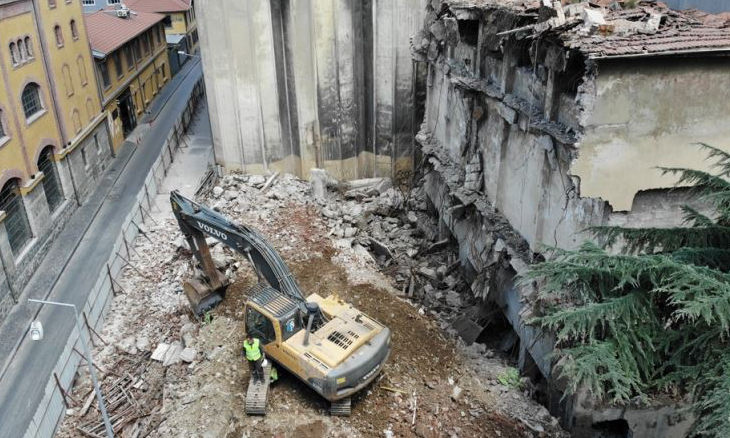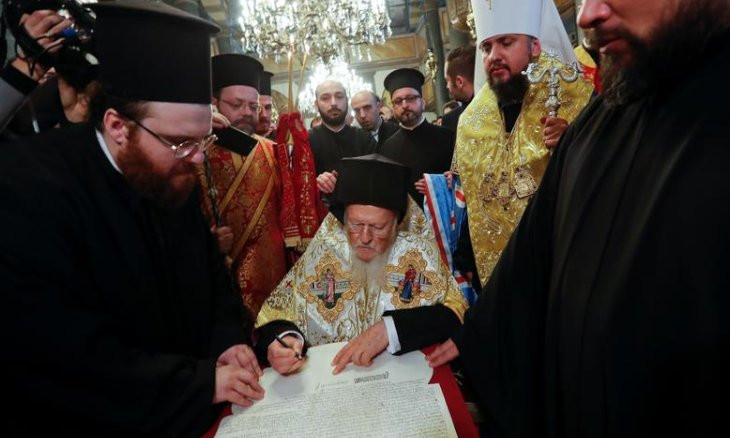The Bomonti front in Turkey's culture wars
Demolishing old distilleries and turning them into Islamic culture centers, alone, has its challenging symbolism, just by itself. It symbolizes the intolerance toward a lifestyle, the tension trying to be kept alive by setting cultural differences in Turkey against each other.
The construction that has begun at the old beer factory at Istanbul’s Bomonti neighborhood is drawing negative reactions not just because it is threatening its historical heritage, but the lifestyle of the area as well. The negative response is entirely appropriate because the factory is one of the last historic industrial buildings in the city, and because a tension seems to be arising that would disrupt the cultural texture of the area that has peacefully occurred over the past few years.

We all know that the Directorate of Religious Affairs (Diyanet) is conducting this demolishment and construction. For a long time, as its name suggests, Bomontiada constituted an “island of culture” here. It will be subject to huge pressure because religious buildings will be constructed next to it. Now that an Islamist policy is dominating in Turkey, it is not difficult to guess how this pressure will end. Due to these reasons, the Bomonti Beer Factory is now the new victim of the cultural and political climate we are going through and the discrimination we are subjected to. Like Hagia Sophia, which was taken from the Ministry of Culture and given to Diyanet, this is a symbol associated with the preferences of the government.
The first story related to what kind of a place Bomontiada would be when it opened appeared in the daily Radikal five years ago with my byline. Two of the three names heading the project, Cem Yegül and Vasıf Kortun, introduced the complex they defined as a “creative culture campus,” and I published a story with diagrams and so on. Right after this story, Bomontiada launched its activities exactly as had been explained. There was a bigger Babylon in it, a chic restaurant named Kilimanjaro, and an art gallery named Alt. It was an entertainment, culture, and art area consisting of office and working spaces to be managed by Autoban, a gourmet market, and a boutique beer production facility. The “Pozitif” team who explained the complex to me and who were heading the project are no longer in charge. The gallery named Alt transformed into the Ara Güler Museum. A tavern was opened in a corner of the complex that was not included in the initial plans. The Bomontiada project became more and more popular. The space was successful because in opposition to Turkey’s increasing conservatism and the trend of closing the streets to entertainment and drinks, this place — like a protected castle — immediately established its own regulars.
When you enter through its arched door, you reach a kind of “entertainment court.” In the small auditorium there are sometimes open air concerts or film screenings, but most of the time people go there to drink their beers in the courtyard to get together with people like themselves. The Bomonti neighborhood takes its name from the historic beer factories. This neighborhood has turned into an attractive living quarter that draws the creative people of the city, not because of the high-rise residence buildings all over the place but because of its organic bazaar, its antique market and Bomontiada. The Diyanet, like a killjoy, has thrown cold water over this, hence the huge negative reaction.
The abandoned buildings right next to Bomontiada were just quietly there until last week. Actually, we had heard last year that they were to be student dormitories and a masjid. Everybody was astounded. It seems that Diyanet quietly took over the buildings years ago. It has had the project prepared consisting of exhibition and meeting halls, art workshops, library, café-bookshop, dormitories, masjid and a parking lot. Its permissions have been completed. The architect who created the project is Halil Onur, the same architect that planned the barracks and shopping mall that were originally planned to be built at Gezi Park.
This area is allocated as a cultural area in the city plans. A cultural facility will indeed be built in this place, but it will be a cultural center supporting Islamist thought, representing exactly the opposite of the culture that has grown in Bomonti in the past years. This situation could have been perceived as pluralism and cultural richness, if there had not been deep fault lines, for a long time, passing through its differences. Or, if the head of the Diyanet, the institute building this project, had not appeared with a sword in his hand during his sermon, becoming the topic of debates concerning insults to Atatürk, the founder of modern Turkey.
The big issue we are experiencing in Bomonti is this possible cultural clash. It is not difficult to guess which side will suffer from this clash. After all, all of us have been living in a Turkey run by the Justice and Development Party (AKP) for the past 20 years.
It looks as if the joy there bothered certain people. The spontaneous cultural environment, the growing number or restaurants, the cafes surrounding Bomontiada, the young people frequenting the area on the weekends or in the evenings, the presence of nearby building from the Mimar Sinan Fine Art University all contribute to the atmosphere of the culture and art, and they all composed an image that had to be broken immediately.
Moreover, we know how much another public institute, other than the Diyanet, passionately wanted these buildings. Yes, Mimar Sinan University was a candidate to take this historic building complex next to its own campus. They continued their efforts officially until the last minute, but somehow, they were not able to overtake the Diyanet.
The demolishment is obviously problematic in terms of protecting cultural heritage too. A very important piece has been lost from the city’s industrial heritage. In Turkey, reconstruction is, truly, the name of demolishing the old one and building a similar one out of paper. Even if there was no way to protect these reinforced concrete buildings, if a sophisticated cultural approach was adopted, a method could have been found to keep the façade and the texture of the factory.
A couple of years later, those young and old, women and men or not, drunk and sober people of entertainment and art will share the same street with the students from the Diyanet dormitories without any problem. But, will the administrators of the building have the same comfort concerning their presence? This is the real problem. For this reason, the first excavation at Bomonti means much more than a historical massacre. It symbolizes the intolerance toward a lifestyle, the tension trying to be kept alive by setting cultural differences in Turkey against each other and many other things that make us live in a tense manner today.
Demolishing old distilleries and turning them into Islamic culture centers, alone, has its challenging symbolism, just by itself. This is a symbolism impossible not to be seen.
 Conversion of Hagia Sophia into mosque risks turning Christians against Muslims, warns Bartholomew
Conversion of Hagia Sophia into mosque risks turning Christians against Muslims, warns Bartholomew

